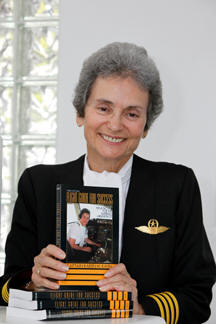During the
majority of my airline flying career, oxygen was a no-brainer. The O2 mask (which we checked dutifully
before every flight, lest we have an explosive decompression which would soon
render us unconscious without it) hung behind my head for 15 years in the MD80
I flew and was stowed in a box outboard of my left knee for my last 10 years in
the Boeing 757/767.
Now, enjoying
retirement flying in my B55 Baron, I’ve missed the easy availability of a quick
shot of “brightener” as I used to call those whiffs, particularly at night,
when the instrument panel seemed a bit fuzzy (through the late hour and long
durations at a 7000'+ cabin altitudes). I’d breathe deeply on the oxygen and then, like magic, the panel would
come back into focus, my brain would reengage and life seemed so much brighter.
Now, in my
elder years, I recall how important those shots of oxygen were and decided if
they helped me that much as a younger full-time professional pilot, just think of
what that same oxygen would do for an older, occasional leisure pilot who’s got
few of those airliner niceties like stretching room, walking areas, lavatories,
etc. Since I try to fly with the
precision of my old airline life, why not give myself a helping hand by using
oxygen to fortify my skills which are not nearly as sharp as they used to be?
As I thought
long and hard about why more pilots don’t use oxygen (when it does such a great
job at making you feel better, fly better and eliminates post-flight headaches)
it occurred to me that my old mantra of “make it easy for someone to do what
you want them to do” was just what I needed to do for myself. Make it easy to don
the nasal cannula, get the oxygen flowing and then, last but not least, see the
benefits quickly.
With these
thoughts in mind, my primary mission during my first Oshkosh Airventure visit
this past summer was to talk to the various nose-hose (as we used to call the
O2 masks) vendors, seeking to find a 2-4 place oxygen system that would work
well for me: easy to install, easy to
use in flight, easy to refill as needed.
I had begun my research several months before and now I was able to see
the various systems and talk to the experts.
I ended up with a Precise Flight OXYpack2
- 2 Person Flow Meter Oxygen System With 15 CU. Ft. Cylinder which interested me for its light
weight, ability to be strapped to the back of the passenger seat and ease of
donning and use without interfering with ongoing pilot activities like speaking
and eating.
I found that the mustache-style cannula, which allows the oxygen
to be conserved and administered through the measured flow meter, was a snap to
put on, even in flight with my headset in place. I merely removed the cannula from the zip
pocket on the outside of the oxygen bottle bag, stuffed it under my headset
band and then slipped the cannula tubes into my nostrils, allowing the hose to
drape over my headset earpieces, down the back of my head and then over my right shoulder.
The best part of my purchase was a small oximeter which
could tell me instantly when I needed to start using the oxygen and how much it was helping
me when I did. Normal readings are above
95% while below 90% is considered critical (see some good info at http://www.easyoxygen.com.au/oxyge http://www.easyoxygen.com.au/oxygen-saturation-levels-and-what-do-they-mean/n-saturation-levels-and-what-do-they-mean/).
During my recent trip from KJAQ to KSBA at 7500 feet, I was
amazed to find my O2 level was down to 90% after only :10-15 at this altitude. I donned the nasal cannula, turned the bottle
all the way on, adjusted the flowmeter to my altitude and settled comfortably to
watch the scenery go by. About :10 later
I checked my O2 level and was pleased to see it back at 96%. I had flown similar
routes in the daytime for many years and never realized how impaired I actually
was while flying at 7,500’ which is technically not an FAA oxygen-mandated altitude. Imagine what using oxygen will do for my
night flights where it's recommended that oxygen be used above 5000 as it improves
night vision, which us oldies-but-goodies can certainly do with more of. My
next night flight should be a real eye-opener…pun intended!
So, do yourself and your flying a favor…since none of us are
getting any younger, enhance your flying with some easy assistance by using
oxygen more often.





